|
Hook, Fight and Net
Walleyes Like a Pro
By
Capt. Michael Veine
It never ceases to amaze me how some anglers manage to catch any fish at
all. It seems like poor fish fighting and netting techniques run rampant on
Lake Erie and other Great Lakes waters. Thousands of walleyes are
unintentionally released every year by anglers that haven't refined their
fish fighting
techniques. Here are some pointers that will put more hooked fish into
your boat.
Fishing Tactics to Improve Hookups
Hooking up solidly with fish in the first place is always the first
critical step.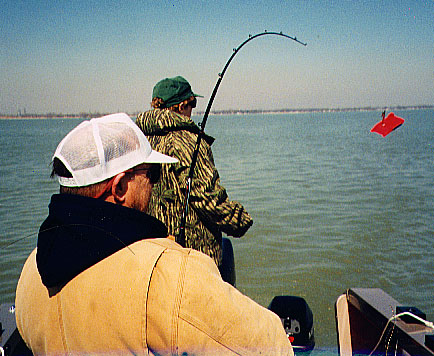 Needle sharp hooks should be at the business end of every walleye angler's
line. I sharpen mine with a hook honing stone. The hooks on nearly all my
walleye lures also receive a minor modification. I bend the hooks outward
slightly to better catch the mouth tissue of the fish. This modification
should only be used when sticky sharp hooks are maintained and with strong
hooks as well.
Needle sharp hooks should be at the business end of every walleye angler's
line. I sharpen mine with a hook honing stone. The hooks on nearly all my
walleye lures also receive a minor modification. I bend the hooks outward
slightly to better catch the mouth tissue of the fish. This modification
should only be used when sticky sharp hooks are maintained and with strong
hooks as well.
Minimizing line stretch is results in more solid hooksets. Trolling with
shorter setbacks will ultimately increase the bite to hookup ratio. This is
the main reason why I attach rubber core sinkers in front of all of my
trolled crankbaits. It allows me to reach deeper depths with less line out.
I also use heavy, low-stretch lines for crawler fishing with bottom
bouncers, my primary walleye tactic from May through summer. Even when
casting or jigging, hooksets become much more consistent with less line out.
When jigging, try to
keep your lines as vertical as possible by using a heavy enough jig. When
casting, keep casts close to the boat allowing the natural fluttering action
of the lure to entice strikes, while at the same time improving hookup
rates.
Hooksets
Setting the hook properly on a walleye is critical. When trolling
properly
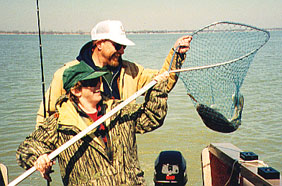 with
inline planer boards, the fish should be allowed to hook themselves. Most
walleye pros agree that the proper way to fish inline boards is so they
never release and stay positively attached to the line. When a fish first
hits an inline board setup this way, resist the temptation to jump up and
yank on the rod. Jerking the line will just bounce the board across the
surface giving the line slack. Walleyes, and especially trophy class fish,
are famous for clamping down on the bait with their bony mouths so hard that
the hooks will not penetrate solidly. If the fish feels a jerk on the line
and then gets slack, it will realize something is wrong and just spit the
bait out; say goodbye. with
inline planer boards, the fish should be allowed to hook themselves. Most
walleye pros agree that the proper way to fish inline boards is so they
never release and stay positively attached to the line. When a fish first
hits an inline board setup this way, resist the temptation to jump up and
yank on the rod. Jerking the line will just bounce the board across the
surface giving the line slack. Walleyes, and especially trophy class fish,
are famous for clamping down on the bait with their bony mouths so hard that
the hooks will not penetrate solidly. If the fish feels a jerk on the line
and then gets slack, it will realize something is wrong and just spit the
bait out; say goodbye.
With steady pressure though, the fish will usually continue to hang on.
We keep the rod in the holder until the walleye pulls the board as far back
as possible.
At that time, maximum tension is being exerted on the line and I can also
determine if other lines may need to be cleared to allow the fish to be
brought to the boat without tangles. When the board stops dropping back, we
simply reel the fish in slowly and smoothly without any jerking or pumping.
When reeled in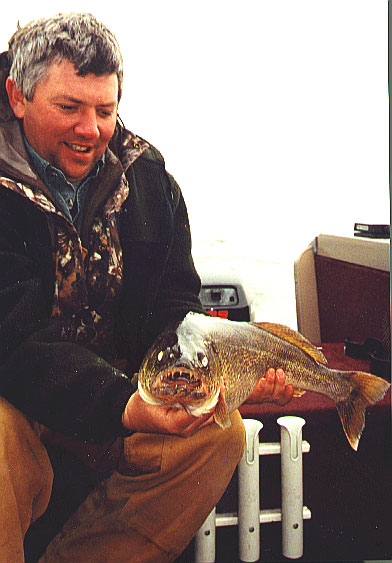 smoothly,
the board will glide to the boat without bouncing and submerging. The angler
continues to reel the board in until it can be detach from the line. When
doing this I stand up on the rear casting platform of my Lund while the
angler either sits down or bends at the knees lowering the rod tip down so I
can reach the board. smoothly,
the board will glide to the boat without bouncing and submerging. The angler
continues to reel the board in until it can be detach from the line. When
doing this I stand up on the rear casting platform of my Lund while the
angler either sits down or bends at the knees lowering the rod tip down so I
can reach the board.
Even when I'm removing the board, the angler keeps reeling in the fish
with the rod tip held high in the air. This keeps the fish moving towards
the boat as smoothly as possible while keeping maximum tension on him at all
times. The drag is set lightly to allow retrieval, but only at a slow pace.
With
this constant tension method, when the walleye does one of his famous
headshakes, the hooks will simply bury deeper into his mouth.
I also keep trolling when a fish is being retrieved, which allows better
tension on the line, keeps the fish in the back of the boat and also allows
the other remaining lines to hook up with those coveted multiple hookups. I
will slow my trolling speed down though if needed especially when trying to
net the fish.
Tournament Winning Refinements
All of my trolling reels are the same Daiwa LC47SG line counters that
feature a star-drag. Out of the box, I take the reels apart and give them a
thorough degreasing. I then apply quality, lithium grease to the gears, drag
system and clicker. This simple process will smooth out the mechanisms
allowing more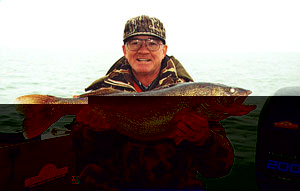 efficient fish retrieval.
efficient fish retrieval.
A star-drag is the best system I've found for serious, experienced
anglers to subdue walleyes and other Great Lakes game fish. Still,
star-drags drive me nuts on charters because inexperienced clients usually
wrap their
knuckles around the knob inadvertently bumping the star drag, which
loosens it up and allows line to pay out resulting in lots of lost fish. For
this reason the clicker always stays on in my boat unless the angler has
proven to me that he or she is cognoscente of gripping the knob by the
fingertips. Savvy anglers
always remove their gloves for this reason as well.
The clicker on all the trolling reels that I've tested tend to impair the
efficiency of the drag system. Stated simply, with the clicker off, the drag
system is much smoother and will catch more fish. With a savvy angler at the
rod, the clicker should be turned off as soon as the rod is pulled from the
holder with a fish-on.
When fighting walleyes during tournaments, you want to retrieve the fish
as quickly as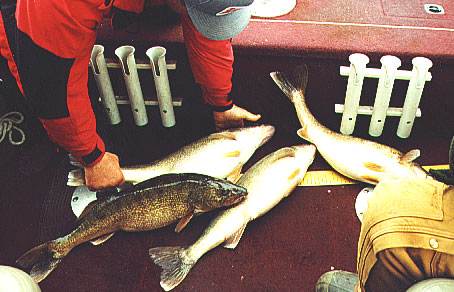 possible, while minimizing the chances of loosing the fish. To accomplish
this, I increase the star drag tension while bringing the board to the boat.
You can get away with this because of the stretch in the line and
possible, while minimizing the chances of loosing the fish. To accomplish
this, I increase the star drag tension while bringing the board to the boat.
You can get away with this because of the stretch in the line and
the shock absorbing action of the board, which further cushions any
action that the fish may take. When my partner is removing the board, I
thumb the drag back a little looser. With a star-drag, quick adjustments can
be made by an expert without upsetting the reeling cadence. As the fish gets
closer to the
boat and line stretch decreases, I loosen the drag even more. If the
walleye is bulldogging below the boat, the drag is set so loose that line
can only be gained by pulling the rod up and reeling down while keeping
constant, steady tension on the fish at all times. This is the only time I
use a conservative pumping technique on walleyes, when the fish is straight
down. If the fish makes a run, I lower the rod and even use my body to
absorb the shock and the loosely set drag also keeps the tension constant.
Some walleyes will inevitably be hooked by the skin of their lip and this
conservative fighting technique will prevent those lightly hooked fish from
tearing loose.
When the board is being retrieved, I always keep the rod tip high with
the rod butt held at a 90-degree angle to the water. Once the board is
removed though a decision needs to be made. If the walleye is on top of the
water and is not fighting to hard, then I keep the fish up and get him to
the boat as quickly as possible by quickening my reeling pace and keeping
the rod tip high.
If the fish is a fighter, then I stick the rod out to the side of the
boat at a 90-degree angle to the stern and keep the rod tip as close to the
water as possible. This way the fish is encouraged to take his fight
underwater where there is less of a chance of him throwing the bait. As the
fish nears
the boat, the rod is raised upward to a horizontal, 90-degree position,
which usually brings him to the surface and the waiting net. If the walleye
stays down throughout the battle, then the most efficient fighting position
is with a horizontal rod in the 90-degree position. Also, by keeping the rod
tip high or out to the side of the boat, if fish does manage to spit the
bait, those dangerous hooks won't fly into the angler or other passengers in
the boat. I have several scars caused by impaled hooks due to negligent
anglers that failed to keep their rod tips up or to the sides.
Netting Fish
Proper netting techniques start with a good net. I use Cummings nets
exclusively. My walleye nets have an 8' long handle and a basket that is 2'
wide. The net bag is deep and the nylon mesh is rubber coated to facilitate
hook removal. I consider this sized net to be ideal in my 22' Lund or any
smaller boat for that matter. If I were fishing from a larger vessel though,
my net would be longer, but the hoop size would remain the same. Walleyes
tend to be spunky fish around the boat, so a smaller hoop size allows quick
net jobs especially when the fish gets around the motors. I have tried
salmon sized nets twice that size, but they just don't work nearly as well.
My nets are all equipped with an Offshore pinch pad clip attached about
8-10" from the base of the hoop. The clip holds the end of the net-bag and
releases it when the weight of the fish hits the net. This little
enhancement will prevent hooks from snagging into the net bag at inopportune
times.
When fighting a walleye to the boat, care should be taken to keep the
fish away from the motors. I run a kicker motor for trolling on my boat,
which is mounted to the port side of my main outboard. I almost always
direct the fish to the starboard side of the stern when trolling, which
keeps the fish away from the prop-wash. When walleyes hit a prop-wash, it
tends to blow them back and they could be lost as a result. If the fish
won't cooperate and go to the starboard side, then we try to bring him to
the net along the port gunnel away from the kicker prop-wash.
When netting a walleye I always wear safety glasses to protect my eyes
from flying hooks. Unless it's really rough, I typically perch myself on my
rear casting platform when netting fish. This allows me to get right on top
of the fish and reach out behind the motors. As the walleye nears the boat,
I always point the net right towards the struggling fish. This way, if the
hooks come loose, the net acts like a shield. I've saved myself from dozens
of flying baits with this technique and it also positions the net for a
quick and efficient net job.
As the fish comes within striking distance of the net, the angler should
smoothly pull back on the rod; sometimes taking a step back is all it takes
to bring the fish straight into the net. With a quick dip, the fish is
scooped up. I then raise the net hoop above the water and work the long net
handle back up the center of the boat far enough until I can back up off the
casting platform and set the fish down on the casting deck for hook removal.
One of the biggest mistakes that I see netters make is to stick the net
in the water and expect the angler to pull the fish into the net. This
improper technique results in untold numbers of needlessly lost fish every
year. I've literally netted tens of thousands of walleyes and other game
fish over the years, so if you have any questions, [email protected]
is my email. |
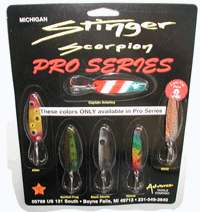
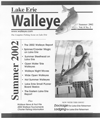

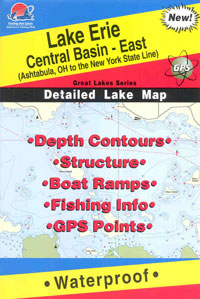
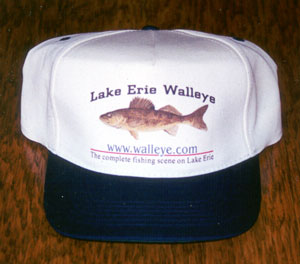
 Needle sharp hooks should be at the business end of every walleye angler's
line. I sharpen mine with a hook honing stone. The hooks on nearly all my
walleye lures also receive a minor modification. I bend the hooks outward
slightly to better catch the mouth tissue of the fish. This modification
should only be used when sticky sharp hooks are maintained and with strong
hooks as well.
Needle sharp hooks should be at the business end of every walleye angler's
line. I sharpen mine with a hook honing stone. The hooks on nearly all my
walleye lures also receive a minor modification. I bend the hooks outward
slightly to better catch the mouth tissue of the fish. This modification
should only be used when sticky sharp hooks are maintained and with strong
hooks as well. with
inline planer boards, the fish should be allowed to hook themselves. Most
walleye pros agree that the proper way to fish inline boards is so they
never release and stay positively attached to the line. When a fish first
hits an inline board setup this way, resist the temptation to jump up and
yank on the rod. Jerking the line will just bounce the board across the
surface giving the line slack. Walleyes, and especially trophy class fish,
are famous for clamping down on the bait with their bony mouths so hard that
the hooks will not penetrate solidly. If the fish feels a jerk on the line
and then gets slack, it will realize something is wrong and just spit the
bait out; say goodbye.
with
inline planer boards, the fish should be allowed to hook themselves. Most
walleye pros agree that the proper way to fish inline boards is so they
never release and stay positively attached to the line. When a fish first
hits an inline board setup this way, resist the temptation to jump up and
yank on the rod. Jerking the line will just bounce the board across the
surface giving the line slack. Walleyes, and especially trophy class fish,
are famous for clamping down on the bait with their bony mouths so hard that
the hooks will not penetrate solidly. If the fish feels a jerk on the line
and then gets slack, it will realize something is wrong and just spit the
bait out; say goodbye.  smoothly,
the board will glide to the boat without bouncing and submerging. The angler
continues to reel the board in until it can be detach from the line. When
doing this I stand up on the rear casting platform of my Lund while the
angler either sits down or bends at the knees lowering the rod tip down so I
can reach the board.
smoothly,
the board will glide to the boat without bouncing and submerging. The angler
continues to reel the board in until it can be detach from the line. When
doing this I stand up on the rear casting platform of my Lund while the
angler either sits down or bends at the knees lowering the rod tip down so I
can reach the board. efficient fish retrieval.
efficient fish retrieval.  possible, while minimizing the chances of loosing the fish. To accomplish
this, I increase the star drag tension while bringing the board to the boat.
You can get away with this because of the stretch in the line and
possible, while minimizing the chances of loosing the fish. To accomplish
this, I increase the star drag tension while bringing the board to the boat.
You can get away with this because of the stretch in the line and